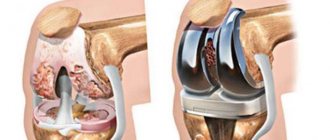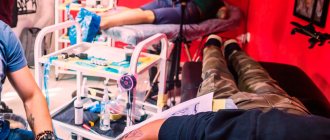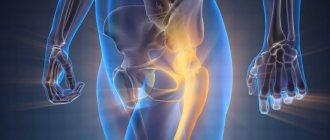Soft tissue sarcomas are a group of malignant tumors arising from the mesoderm - the precursor cells of connective tissue, as well as adipose, muscle, nervous, etc. Such formations are characterized by rapid growth and tend to metastasize. They can occur in any organ of the body, most often found on the legs and lower half of the torso, shoulders, and less often on the arms, head, and neck.
Although sarcomas are diagnosed relatively rarely—about 1% of all cancer cases—they are very dangerous due to the aggressiveness of the disease and high mortality rate. In addition, the disease occurs even in children (5-6% of all cancers), so if there are any signs of a tumor, you must immediately consult a doctor in order to establish a diagnosis and begin treatment as soon as possible.
Hospitalization of cancer patients. Daily. Around the clock
9,500 patients trust us annually.
Call your doctor now!
How does sarcoma develop?
Is sarcoma cancer?
Official medicine in Russia and some other countries refers to cancer as malignant tumors that develop in epithelial cells contained in the skin or mucous membranes and lining the inner surface of organs. Sarcomas are not tied to specific organs, they form in different types of tissues, but behave in a similar way - they grow quickly, damage healthy cells and metastasize. Metastasis is an additional focus of cancer - a new tumor in an organ located far from the main tumor, including in lungs, bones and liver.
The disease begins with the appearance of just one mutated or altered cell. It becomes this way under the influence of radiation, various chemicals, diseases or hereditary characteristics, and gradually multiplies, creating copies of itself. Over time, they become more and more numerous, they turn into a tumor and destroy surrounding tissues. In addition, they have a special, very dangerous property - they know how to move around the body using the circulatory and lymphatic systems. The lymphatic system complements the cardiovascular system. The lymph circulating in it - the intercellular fluid - washes all the cells of the body and delivers the necessary substances to them, taking waste from them. In the lymph nodes, which act as “filters,” dangerous substances are neutralized and removed from the body, become established in other areas of the body and create additional tumors.
Types of soft tissue sarcomas
Doctors know of more than 50 different types of such tumors, the most common of which are:
- Fibrosarcomas
affecting the connective tissue of the legs, arms or torso. They most often occur in people between 20 and 60 years of age, but can even occur in infants. - Angiosarcomas
are hemangiosarcomas that begin in blood vessels, or lymphangiosarcomas that begin in lymphatic vessels. They appear, among other things, in those parts of the body that have been exposed to radiation therapy, in the chest area and in the extremities with lymphedema - an accumulation of lymphatic fluid in the tissues. Lymph is an intercellular fluid that washes all the cells of the body and delivers necessary substances to them, taking away waste . due to disruption of its outflow. - Leiomyosarcoma -
originating in smooth muscle, is often found in the abdominal cavity, but can also be found in other parts of the body, such as the extremities or the uterus. - Synovial
- Forms in the tissues surrounding the joint, usually in the hip, knee, ankle and shoulder. - fibromyxoid
sarcomas are slow-growing tumors usually found in young and middle-aged patients. - Kaposi's sarcoma -
develops in the cells lining lymphatic or blood vessels. - Alveolar cancer
is a rare type of oncology, mainly affecting young patients. - Neurofibrosarcomas, malignant schwannomas and neurogenic sarcomas
arise in cells surrounding the nerve. - Liposarcomas are
tumors of adipose tissue that most often form in people aged 50 to 65 years. - Clear cell -
usually develops in the tendons of the arms or legs. - Rhabdomyosarcomas
are the most common type of soft tissue sarcoma in children. - Epithelioid
- usually damage the tissue of the hands, forearms, feet or legs of adolescents and young patients.
Gastrointestinal stromal tumors- Low-grade myxofibrosarcomas are most often found on the extremities of older people.
- Malignant mesenchymomas -
have features of fibrosarcoma and at least two other types of sarcomas.
Symptoms
Soft tissue sarcoma manifests itself as a small nodular compaction, which is characterized by immobility. The dimensions of the neoplasm can be different, but at first they are within 2-5 cm. The skin over the lesion often remains the same, but sometimes there is excessive convexity of the venous network. Typically, only swelling remains the fundamental symptom of the tumor in question.
However, often the pathogenic formation develops in the deep layers of tissue, so even the smallest signs are absent altogether. This progression option involves the gradual development of swelling and an increase in pain in the affected limb (if the focus is located there). If the leg is affected, for example, it may cause lameness or pain when walking. If pathology forms in the forearm, contracture of muscle tissue and articular components appears.
Reasons for the development of sarcoma
Doctors do not know the exact causes of such tumors - modern medicine only knows about factors that increase the likelihood of this event.
Radiation
, used to combat various types of oncology. Sarcomas can occur in parts of the body that have been exposed to radiation therapy. On average, about 10 years pass from the time it is carried out until the disease is detected. Treatment methods have been improved over several decades, and much more is known about choosing the right doses than before. Modern knowledge is helping to reduce the number of new diagnoses, but even today radiation is only used when its benefits outweigh the risks.
Heredity
. Some disorders caused by changes in genes are often inherited from parents and are associated with an increased likelihood of developing soft tissue sarcomas. These include:
- Gardner's syndrome
, leading to the appearance of a large number of polyps - growths of intestinal tissue; - neurofibromatosis
, which causes the formation of multiple nerve tumors; - Li-Fraumeni syndrome
, which increases the risk of breast cancer, brain tumors, sarcomas and leukemia - changes in bone marrow and blood cells; - retinoblastoma
is a life-threatening eye tumor that develops mainly in children; - Werner's syndrome
is a genetic disease, the owners of which age prematurely, suffer from cataracts - clouding of the lens, blockage of the heart arteries and other health problems; - tuberous sclerosis
, which causes seizures and a variety of tumors in various tissues and organs, including the brain, eyes, skin, heart, kidneys, liver, lungs and gastrointestinal tract; - Gorlin syndrome
, which increases the likelihood of developing many types of skin cancer, fibrosarcomasFibrosarcomas affect the connective tissue of the legs, arms or torso. They most often occur in people between 20 and 60 years of age, but can even occur in infants. and rhabdomyosarcomasRhabdomyosarcomas are the most common type of soft tissue sarcoma in children.
Chemicals
, such as arsenic and vinyl chloride, used in the production of plastics, increase the risk of liver sarcoma.
Damage to the lymphatic system
. Lymph is a clear liquid containing cells of the immune system, which are transported throughout the body through blood vessels and lymph nodes, which act as “filters” that retain and neutralize dangerous substances. If these important organs are damaged or after their removal, a person may develop lymphedema - accumulation of lymph and swelling, as well as its complication - lymphangiosarcoma. Lymphangiosarcoma is a life-threatening tumor that develops in the lymphatic vessels.
Injuries, lifestyle and bad habits, including smoking, poor diet and lack of exercise, do not increase the likelihood of developing sarcoma.
Risk factors
The causes of soft tissue sarcoma are not precisely known, but some risk factors include:
- undergoing radiotherapy;
- certain genetic diseases, for example: neurofibromatosis;
- Gardner's syndrome;
- Li-Fraumeni syndrome;
- retinoblastoma
- insecticides or herbicides (substances used to kill insects or plants);
to come back to the beginning
Signs and symptoms of soft tissue sarcoma
About half of them occur in the arms or legs. Most people notice a swelling that gradually enlarges over weeks or months without always being painful.
About 4 out of 10 sarcomas develop in the abdominal cavity - the abdomen, which causes not only discomfort, but also blockage of the digestive tract or bleeding from the stomach and intestines. In addition, they can put pressure on nerves, blood vessels and nearby organs, and can grow to very large sizes.
In rare cases, tumors appear in the chest, head or neck.
Possible signs of the disease include:
- the appearance of a new swelling or lump in any area of the body and the growth of existing ones;
- increasing abdominal pain;
- blood in the stool or vomit, as this may be caused by damage to the digestive tract from a growing tumor;
- black, tarry stools that acquire a similar color and consistency due to bleeding in the stomach or intestines.
Most often, the above symptoms are not caused by sarcomas, but if they appear, you should immediately consult a doctor.
Long Term Care
Your health care experience at Memorial Sloan Kettering (MSK) is a long process. You will see your doctor every 4 to 6 months for the first 3 years after treatment ends. At each of these follow-up visits, you will be examined by a doctor and have an X-ray or CT scan.
After the early follow-up period, you will see your doctor every 6 to 12 months for the next 5 years. After this, you will only see your doctor once a year or once every two years.
Your doctors and nurses are committed to your long-term health care. Please contact them at any time during the period of such service if you have any questions or concerns.
to come back to the beginning
Diagnosis of soft tissue sarcoma
Detailed information about the disease and the general state of a person’s health allows us to choose the most appropriate treatment for each individual patient.
Highly qualified oncology specialists carry out a complete diagnosis of soft tissue sarcomas using the most modern equipment - quickly, efficiently, without queues and loss of time.
The examination begins with a general examination and a survey about symptoms and family diseases, after which the doctor prescribes a series of tests.
The first of these may be conventional radiography.
. With its help, immediately after diagnosis, doctors can see whether the tumor has spread to the lungs.
– computed tomography: X-rays create detailed images of internal organs and tissues. The method is used to detect tumors in the chest or abdominal cavity, as well as to detect damage to the lungs, liver and other organs.
MRI
– Magnetic resonance imaging: radio waves and strong magnets often work better than CT scans. MRI can provide information about the size of the sarcoma, its location, and sometimes even the type of tissue it consists of. In addition, this study is prescribed to study the condition of the brain and spinal cord.
Ultrasound
Using ultrasound waves, a specialist can distinguish seals from ordinary cysts - fluid-filled sacs.
PAT
– positron emission tomography: before performing this study, the patient receives radioactive sugar, which accumulates in dangerous tumors. A scan is then performed to show whether changes in the tissue are cancerous.
If a soft tissue sarcoma is suspected, the doctor prescribes a biopsy
, during which a small piece of the tumor is removed and sent to a laboratory where its cells are carefully studied.
Causes of soft tissue tumors
Tumors of any location are still the subject of study in modern clinical centers around the world. Unfortunately, science still cannot give an exact answer about the reasons for the appearance of benign or malignant tumor growths.
Thanks to a retrospective analysis of medical records of many patients, it was possible to identify risk factors that contribute to a significant increase in the likelihood of developing the disease. Possible reasons include the following:
- Frequent tissue injury, which leads to disruption of mitotic cell division processes;
- The presence of scar changes in a certain area often leads to the phenomenon of malignancy, due to which the connective tissue can become fibrosarcoma;
- Genetic predisposition - it is believed that the presence of a history of tumor diseases in close relatives leads to an increase in the likelihood of a similar pathology by 70%;
- Infection with human papillomavirus;
- Tuberous sclerosis disease;
- Impact of polluted environment;
- Frequent and prolonged exposure to low doses of radiation;
- Abuse of alcohol and tobacco products.
Stages of soft tissue sarcoma
Immediately after the disease is detected, doctors try to stage it - to understand how far it has spread throughout the body and damaged tissue. This information allows us to understand the patient’s approximate prognosis and select the most appropriate treatment methods for him.
Staging of soft tissue sarcomas is carried out according to the international TNM
, each letter of which has its own meaning:
- " T
" describes the size of the underlying neoplasm; - “ N
” – damage to nearby lymph nodes; - “ M
” - the presence of metastases - additional foci of the disease in other areas of the body.
Using " G"
"indicate:
- The degree of difference between tumor cells
and healthy ones is from 1 to 3. One is assigned to cells that are most similar to normal tissues, and 3 is assigned to highly altered cells; - The number of dividing cells
is from 1 to 3. The fewer there are, the lower the score. - Necrosis
: a score from 0 to 2 is given to determine the amount of dying tissue - the higher the number, the more there is.
Then the total number of points is calculated: G1 – from 2 to 3; G2 – from 4 to 5; G3 – from 6 to 8.
Stages:
1A
: the size of the sarcoma does not exceed 10 centimeters, the remaining tissues are healthy.
1B
: the tumor may be larger than 15cm, but its cells are very similar to normal, and other organs are not affected.
2
: the tumor is no more than 5cm in diameter, but is graded G2 or G3.
3A
: sarcoma from 5 to 10 cm, G2 or G3.
3B
: 10 to 15 cm, G2 or G3, but other tissues are healthy.
Or, if the tumor is located in the abdomen, any size of the main lesion and damage to the nearest lymph nodes. 4
: a tumor of any diameter and type G, which has damaged not only nearby lymph nodes, but also distant tissues, such as the lungs.
Treatment of soft tissue sarcoma
The fight against oncology is not an easy task, and requires the participation of not just one doctor, but a whole team of professionals.
The oncology department carries out all types of diagnostics and therapy of sarcomas using the most modern equipment. Our world-class specialists fully guide the patient and provide him with all the necessary assistance - quickly, efficiently, without queues or waste of time.
Each situation is unique and requires an individual approach and a combination of different techniques:
Surgery
, with which some tumors can be completely cured. The purpose of the operation is to remove the entire tumor and a certain amount of healthy tissue surrounding it - at least 1-2 centimeters, so that no altered cells remain in the human body. In the past, many patients with sarcomas on the arms and legs were treated with limb amputation. Today this method is rarely used, and only in some cases it is not possible to avoid this traumatic procedure. In addition, there are situations when, along with oncology, it is necessary to remove important nerves, muscles, bones and blood vessels.
Even if the disease has spread to distant parts of the body, such as the lungs or other organs, surgery can cure a person or prolong his life.
Radiation therapy
: Targeting the tumor with radioactive beams or particles is a key part of the fight against soft tissue sarcomas.
In most cases, this procedure is prescribed as an adjuvant
treatment after surgery.
With its help, specialists kill the altered cells remaining in the body and prevent the recurrence of the disease. Some patients require neoadjuvant
therapy, used before surgery to shrink the tumor and make it easier to remove. In addition, radiation can be used as a palliative - to relieve the symptoms of an advanced disease that cannot be cured.
There are several types of radiation therapy:
- classic external
, in which the effect occurs externally, through the skin; - intraoperative
, which involves irradiating tissue after tumor removal, before closing the wound; - brachytherapy - injection of small granules of radioactive material into areas damaged by sarcoma;
- and proton
therapy, which uses streams of protons instead of X-rays - positively charged particles precisely aimed at the changed cells.
Chemotherapy
– the use of special drugs that kill tumor cells.
They are injected into a vein or taken orally as tablets and reach all areas of the body. Thanks to this property, the method is effective even at advanced stages of the disease. Depending on the type and stage of sarcoma, this procedure can be prescribed as the main or auxiliary treatment - in addition to surgery, and combined with radiation therapy. Some patients require a special type of chemotherapy called isolated limb perfusion
. During this procedure, a specialist separates the blood circulation of the affected arm or leg from the rest of the body, after which it injects the active substances.
Targeted therapy
– drugs that attack only certain components of altered cells and cause minimal harm to healthy ones.
Pazopanib
(
Votrient
): Blocks several enzymes important for cell growth and survival—proteins that initiate or speed up the chemical reactions needed to copy genetic information. It can be used to treat advanced soft tissue sarcomas that have not responded to chemotherapy. It slows tumor progression and eases side effects in patients whose tumors cannot be treated with surgery.
Tazemetostat (Tazverik
): affects a protein that promotes the growth of some cancer cells. It is used for epithelioid sarcomasEpithelioid sarcomas typically damage tissue in the hands, forearms, feet, or legs of adolescents and young adults that cannot be removed by surgery.
Treatment of soft tissue sarcoma by stages
At each stage of the disease, certain methods of therapy are used:
Stage 1
: Small tumors of the extremities are removed through surgery, followed by radiation therapy if necessary. If the sarcoma is located in other areas of the body - the head, neck or abdomen, radiation or chemotherapy is prescribed before the intervention to reduce the size of the tumor.
Stages 2 and 3
: also treated surgically, in rare cases amputation of the damaged limb is performed. Chemotherapy and radiation therapy may be prescribed before and after the procedure.
Stage 4
: Rarely can be completely cured. The highest chances of recovery are in patients whose tumors - primary and secondary - can be removed during surgery. If this is not possible, targeted, chemotherapy and radiation therapy are prescribed to reduce the symptoms of the disease, prolong life or improve its quality.
Types of soft tissue cancer
The most common type of skin cancer is basal cell carcinoma . This is a thickened area of skin that has a normal color or a pearly-waxy tint. Typically found in the arms, neck or head, up to 20% of lesions are found on the remaining parts of the body.
Another option for skin lesions is squamous cell carcinoma , which looks like a non-healing ulcer, spots with detachment of epithelial scales, and compacted reddened tubercles. The most common localization is the back and chest area, face or arms, neck, ears.
Another type - the most aggressive - is melanoma , a tumor that occurs in the area of moles (pigmented areas of the skin). It is characterized by rapid progression and high malignancy. Usually located in the interdigital spaces, in the groin, on the head, torso, and back.
Prognosis and survival of soft tissue sarcoma
Each person's outlook is different and depends on a variety of factors, such as age, general health, type of disease, stage, location of the tumor, and response to treatment.
To present approximate forecasts, doctors use a special term - “five-year survival rate”. This statistic says nothing about a person's chances - it only shows the percentage of people still alive 5 or more years after diagnosis.
For soft tissue sarcoma the numbers look like this:
- at localized stages, before the tumor has time to spread beyond the area in which it first appeared: approximately 81%;
- at regional stages, with damage to nearby tissues or nearby lymph nodes: about 56%;
- when the disease spreads to distant parts of the body such as the lungs: 15%.
Resources
The Kristen Ann Carr Fund www.sarcoma.com The Kristen Ann Carr Fund is a resource for people diagnosed with soft tissue sarcoma. Every year the foundation prepares a newsletter “Up-to-date information on the problem of sarcoma.” You can find more information about soft tissue sarcoma on the foundation's website.
Cancer.Net www.cancer.net/cancer-types/sarcoma-soft-tissue/introduction Cancer.Net provides information about soft tissue sarcoma, including videos and blog posts.
This website also has a Spanish version. Visit the website for more information. to come back to the beginning









